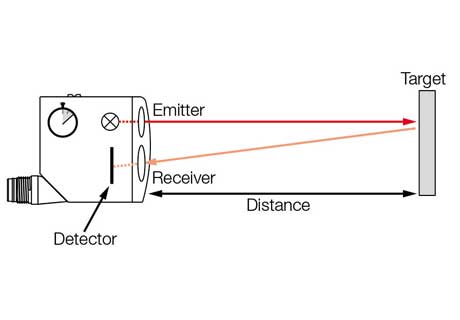Can Photoelectric Sensor Measure Distance?
Key Takeaway
Yes, photoelectric sensors can measure distance by calculating the time delay between emitting and receiving light, with some models capable of measuring distances with precision up to several meters.
Capabilities of Photoelectric Sensors in Distance Measurement
Understanding the capabilities of photoelectric sensors in distance measurement is crucial for implementing them effectively in various industrial applications. These sensors, known for their precision and reliability, offer significant advantages in distance tracking when used correctly.
Photoelectric sensors are adept at determining the distance to an object based on the time it takes for light to travel from the sensor to the object and back again. This method, known as time-of-flight, involves emitting a light signal towards the target and measuring the time interval until the light is received after reflecting off the target. The accuracy of distance measurements made by photoelectric sensors can be highly dependable, making them suitable for applications where precise spatial data is necessary, such as in automated warehousing systems where inventory location accuracy is paramount.

How Photoelectric Sensors Calculate Distance
The process begins with the sensor emitting a light beam towards the target. By calculating the time it takes for this light to return, the sensor can determine the distance to an object. This calculation relies on the constant speed of light, allowing for precise distance measurements. The technology behind these calculations involves either continuous wave modulation or pulse modulation, each providing different benefits depending on the application’s requirements. Continuous wave systems are typically more complex but offer higher accuracy, while pulse systems are simpler and are used in environments where high-speed measurements are less critical.
Advantages of Using Photoelectric Sensors for Measuring Distance
The use of photoelectric sensors for measuring distance offers several compelling advantages, particularly their non-contact nature. This critical attribute ensures that there is no physical interaction with the target object, which significantly reduces wear and tear on both the sensor and the object itself. This aspect is especially beneficial in sectors like food and beverage or pharmaceutical manufacturing, where contamination from contact could compromise product integrity.
Furthermore, the non-contact approach of photoelectric sensors enhances the operational lifespan of the equipment, as it eliminates the mechanical stress and subsequent maintenance typically associated with contact-based systems. It also improves safety within the manufacturing environment, as it reduces the risk of accidents caused by mechanical failure or interference with moving parts.
Additionally, these sensors are capable of providing rapid and precise measurements, which is vital in high-speed production lines. Their ability to quickly and accurately gauge distances ensures that processes run smoothly and efficiently, with minimal downtime. This speed and precision, combined with their durability and safety, make photoelectric sensors an indispensable tool in modern industrial automation.
Limitations in Distance Measurement with Photoelectric Sensors
Despite their versatility and widespread use, photoelectric sensors encounter certain limitations when it comes to distance measurement. The material and color of the target object can significantly influence the sensor’s accuracy. Transparent materials, for example, might not reflect the light beam back to the sensor effectively, while dark or absorbent colors could diminish the light’s intensity, resulting in underestimations of distance.
Environmental factors also play a crucial role in the performance of these sensors. Ambient light can interfere with the sensor’s light beam, potentially skewing the data it collects. Similarly, atmospheric conditions such as fog, dust, or heavy rain can scatter or absorb the light beam, which complicates the sensor’s ability to pinpoint the object’s precise location.
Moreover, highly reflective objects pose their own unique challenges. Such objects can reflect the light beam away from the sensor or create multiple reflections that confuse the sensor, leading to erroneous distance measurements. Navigating these challenges requires a nuanced understanding of both the sensor’s capabilities and the operational environment, emphasizing the need for careful selection and calibration of photoelectric sensors to ensure accurate and reliable readings.
Best Practices for Accurate Distance Measurement
Achieving precise distance measurements with photoelectric sensors requires a combination of careful selection, strategic setup, and consistent maintenance. First and foremost, it’s vital to choose a sensor that aligns with the specific demands of your application. This means selecting a sensor with a light source and configuration that are best suited to the material properties of the target and the environmental conditions of the workspace. For example, a sensor that uses infrared light might be more effective in dusty conditions, while a laser-based sensor could offer better precision in clear environments.
Additionally, the setup of the sensor must be meticulously planned. Proper alignment and positioning are essential to ensure the light beam accurately interacts with the target object without any obstructions or unwanted reflections. This setup process might include adjustments to the sensor’s angle and height, as well as considerations for any potential sources of interference.
Regular calibration and maintenance of the sensor are equally important. Over time, factors such as vibration, exposure to extreme temperatures, and even routine wear and tear can affect a sensor’s accuracy. Scheduled calibrations and routine checks can help catch and correct these issues before they lead to measurement errors. Furthermore, protective measures should be put in place to shield the sensor from environmental challenges like moisture and dust, which can degrade its performance. By following these best practices, you can ensure that your photoelectric sensors deliver reliable and accurate distance measurements, enhancing the efficiency and quality of your operations.
Conclusion
Photoelectric sensors offer a powerful tool for precise distance measurement across various industries. By understanding their capabilities, how they calculate distance, and the best practices for their use, you can effectively integrate these sensors into your systems. Whether for simple positioning tasks or complex automated processes, photoelectric sensors provide the accuracy and efficiency needed to enhance operational reliability and performance.
